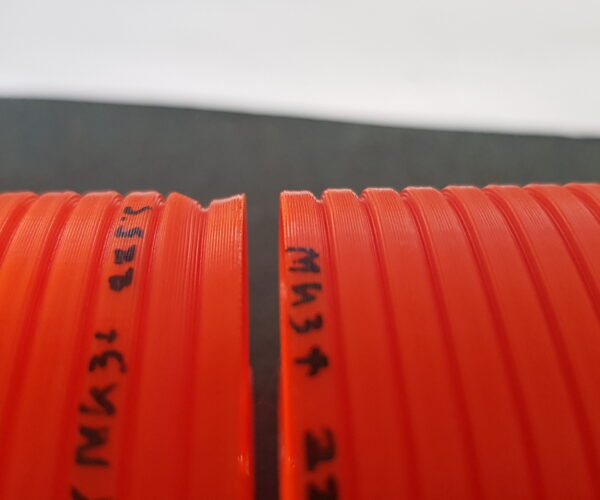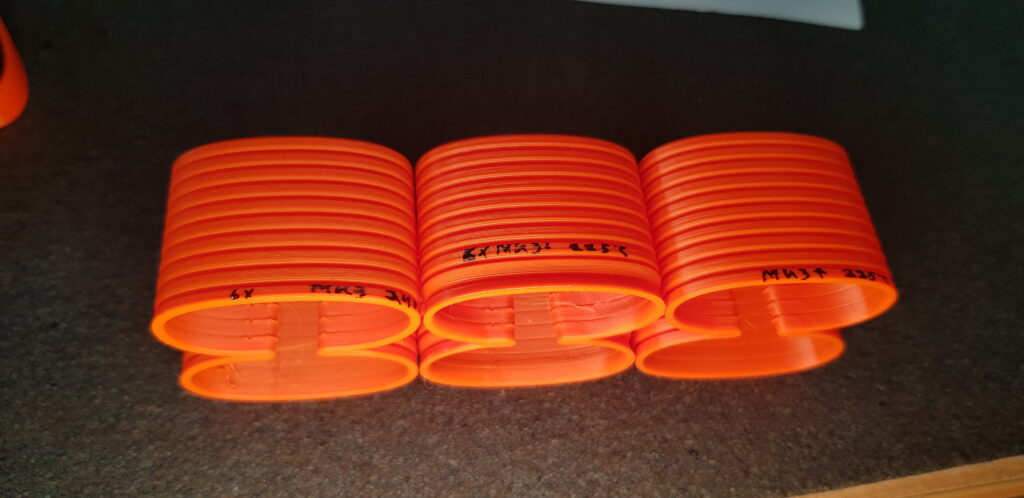Strange shrink/deformation first~30 layers when printing multiple Prusa PET parts
Note, In this comparison I compare 2 different printer setups, one is an MK3 fully stock-ish. Other is MK3S+ with Dragon High Flow hotend.
I am trying to get 2 different slicer settings for both printers to match eache other as close as possible to a good resulting print. This means in general that I turn UP the temperature on the stock E3D hotend. And I turn DOWN the temperature on the Dragon High Flow hotend to try and get the same layer adhesion results and same looking "matte" finish from printing PETG slightly to cold.
I'm trying to wrap my head around this problem.
I have a 3D print that I stack and want to decrease in layer bonding so its easy to seperate. I'm trying to lower the temperature on the printer with the dragon HF so that parts become easy to separate. When I print a single tower on the plate all is well and I'm pleased with the result (No stringing, Matte-ish finish, Nice separation).
Now when I print 6x towers on the plate at the same time, I suddenly get a strong "shrink" in the first 30 layers... As you can see here: 
Left: 6x at the same time. Right: same slicer settings, only printed 1x on the bed.
And to make it even more confusing, I am printing the same objects on the stock prusa MK3 printer and there 6 towers does not give me an deformation. As seen here : 
Left: stock MK3 6x towers on one bed, Mid: MK3S+ 6x tower on one bed, Right: MK3S 1x tower on one bed.
I started an 2nd batch of 6 on the MK3S+ with Dragon HF to confirm it is repeatable, and to see when the deformation is forming. It happend again, and is directly forming when the layers are being printed (so not over long time annealing from the 90°C bed temperature, and this should then also happen on the MK3 witch it does not).
So I know I have a lot of difference between the 2 printers with different hot-ends and temperature settings. I am only trying to figure out:
1. What is the physics behind this deformation. why it is happening?
2. Why is it only happening when printing multiple towers and not when printing a single tower?
3. Why is it happening at the colder High-FLow nozzle, and not at the hotter E3D nozzle both with multiple towers on one bed?
4. How to solve this problem the best while still using colder temperatures in a High Flow nozzle?
Some printing details :
MK3S+ Dragon HF = 225°C / 90°C Bed
MK3 stock = 247°C / 90°C Bed
Best Answer by AcE Krystal:
I think I figured it out. I don't really know the right therms but let me try explain.
I think it had to do with plastic crystalizing / annealing to a certain degree during normal printing temperatures. So the material exiting the nozzle might be more resistend to softening/shrinking then before it went through the nozzle/heating process.
Since its only happening close to the build plate for ~5mm only when printing at lower temps then advertised on the PET spool an printing on 90degree buildplate this seemes to me a very plosible explenation.
To test this I lowered the buildplate from 90 to 60degree, and the parts now look fine without any deformation.
I'm not yet 100% sure if annealing the first bed heated layers is the right description. As I see the deformation directly happen as it is printing. On the other hand, the deformation was not really present when printing only one object, it starts to show only on longer/multiple object print beds. So time per layer seems to play a role.
My conclusion:.. if you have this problem when wanting to print PET on lower temperatures. Lowering your bed temperature seems to be needed on longer prins
Creative Engineer and 3D printing @ AcEcraft.eu
RE: Strange shrink/deformation first~30 layers when printing multiple Prusa PET parts
By "High flow nozzle" do you mean the one with a split pathway where the filament is split into three strings before being united again at the nozzle tip?
Mk3s MMU2s, Voron 0.1, Voron 2.4
RE:
no, Dragon hot-end high flow version has a bigger copper area above the nozzle. I'm using a standard 0.4mm E3D hardend steel nozzle.
Sorry I see my error now :). I mean High Flow Hot-End instead of High flow nozzle XD
Creative Engineer and 3D printing @ AcEcraft.eu
RE: Strange shrink/deformation first~30 layers when printing multiple Prusa PET parts
Hm, weird then. It must have something to do with the slower layer progression and therefore differences in part cooling per layer. That it is worse directly above the bed would suggest it is worse at higher ambient temperatures. I don't say I can make sense out of it either.
Mk3s MMU2s, Voron 0.1, Voron 2.4
RE: Strange shrink/deformation first~30 layers when printing multiple Prusa PET parts
I think I figured it out. I don't really know the right therms but let me try explain.
I think it had to do with plastic crystalizing / annealing to a certain degree during normal printing temperatures. So the material exiting the nozzle might be more resistend to softening/shrinking then before it went through the nozzle/heating process.
Since its only happening close to the build plate for ~5mm only when printing at lower temps then advertised on the PET spool an printing on 90degree buildplate this seemes to me a very plosible explenation.
To test this I lowered the buildplate from 90 to 60degree, and the parts now look fine without any deformation.
I'm not yet 100% sure if annealing the first bed heated layers is the right description. As I see the deformation directly happen as it is printing. On the other hand, the deformation was not really present when printing only one object, it starts to show only on longer/multiple object print beds. So time per layer seems to play a role.
My conclusion:.. if you have this problem when wanting to print PET on lower temperatures. Lowering your bed temperature seems to be needed on longer prins
Creative Engineer and 3D printing @ AcEcraft.eu